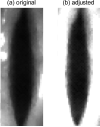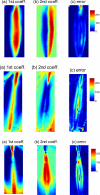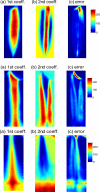The glottaltopogram: a method of analyzing high-speed images of the vocal folds
- PMID: 25170187
- PMCID: PMC4142715
- DOI: 10.1016/j.csl.2013.11.006
The glottaltopogram: a method of analyzing high-speed images of the vocal folds
Abstract
Laryngeal high-speed videoendoscopy is a state-of-the-art technique to examine physiological vibrational patterns of the vocal folds. With sampling rates of thousands of frames per second, high-speed videoendoscopy produces a large amount of data that is difficult to analyze subjectively. In order to visualize high-speed video in a straightforward and intuitive way, many methods have been proposed to condense the three-dimensional data into a few static images that preserve characteristics of the underlying vocal fold vibratory patterns. In this paper, we propose the "glottaltopogram," which is based on principal component analysis of changes over time in the brightness of each pixel in consecutive video images. This method reveals the overall synchronization of the vibrational patterns of the vocal folds over the entire laryngeal area. Experimental results showed that this method is effective in visualizing pathological and normal vocal fold vibratory patterns.
Keywords: high-speed videoendoscopy; principal component analysis; vocal fold vibration.
Figures














References
-
- Adams R, Bischof L. Seeded region growing. Pattern Analysis and Machine Intelligence. IEEE Transactions on. 1994;16(6):641–647.
-
- Baken RJ. Electroglottography. J. Voice. 1992;6:98–110.
-
- Döllinger M, Braunschweig T, Lohscheller J, Eysholdt U, Hoppe U. Normal voice production: computation of driving parameters from endoscopic digital high speed images. Meth. Inf. Med. 2003;42(3):271–276. - PubMed
-
- Döllinger M, Lohscheller J, Svec J, McWhorter A, Kunduk M. Support vector machine classification of vocal fold vibrations based on phonovibrogram features. In: Ebrahim F, editor. Advances in Vibration Analysis Research. InTech; Croatia: 2011. pp. 435–456.
Grants and funding
LinkOut - more resources
Full Text Sources
Other Literature Sources
